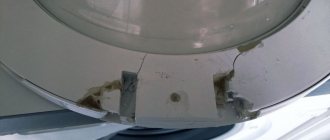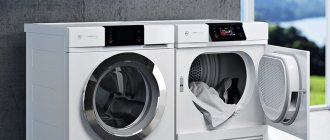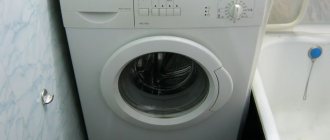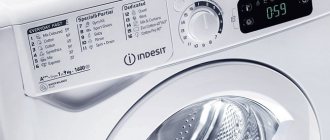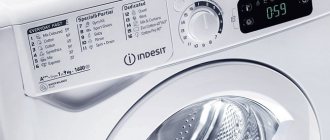A washing machine is an important household appliance that can be placed in a free corner and not be played up in the interior. But the limited size of apartments forces us to resort to more reasonable ways of arranging equipment. For example, a washing machine built under the countertop will look neat both in the kitchen and in a small bathroom. This article discusses the types and sizes of built-in machines, and also provides an overview of models suitable for installation under a countertop.
You can install a washing machine under the countertop both in the kitchen and in the bathroom
Main dimensions of automatic washing machines
Washing machines are characterized by 3 size parameters:
- width - the distance between the sides of the equipment. It varies from 60 to 85 cm;
- height - the size from the floor to the top of the device. It ranges from 47 to 90 cm;
- in depth - measured from the front wall of the device to its rear panel. The distance can be from 32 to 60 cm.
So many different indicators can be achieved by changing the size of the drum and the type of loading. As a result, the maximum capacity of the equipment drum often changes.
Front-loading and top-loading washing machines
Depth of narrow models
Narrow washing machines are those with a width of up to 400 mm. Most often, the maximum load of laundry for these models is up to 4 kg. In some cases, manufacturers lengthen the drum without changing the depth, so the load of laundry can weigh up to 5 kg.
An example of this type of washing machine is Candy CS-34 1051 D1/2. The depth of this model is 340 mm, and up to 5 kg of clothes for washing can be placed in the drum.
These machines have certain disadvantages:
- poor stability and significant vibration,
- the narrow tank prevents the normal rotation of the washing powder, so the quality of the washed items when the drum is fully loaded is lower,
- rapid wear of working elements and shorter operating time as a result of significant vibration,
- increased noise.
The main advantage of automatic machines, in contrast to standard ones, is their shallower depth, which allows them to significantly save space in the room.
Dependence of height on machine type
The height and depth of the washing machine can be determined by the type of load. There are 2 types of it:
- vertical - the hatch for linen is located on top of the device and is an opaque cover;
- frontal, or horizontal - the hatch for loading laundry is located on the front panel of the machine and is a transparent door.
Often full-size vertical and horizontal devices do not differ in height. They are installed free-standing, and therefore standard sizes of 85-90 cm provide the greatest comfort for the user.
Differences between the heights of these 2 types appear in compact and mini models. The lowest options are found in top-loading types, due to their design features.
Front loading washing machines
The sizes of front-loading washing machines vary greatly. It depends on the type of model:
- full-size - with standard dimensions of 85-90 cm in height, 60 in width and 60 in depth;
- built-in - with a distance from the floor to the top point of 85 cm, 60 in depth and 60 in width;
- compact - washing machines are smaller in size than standard ones - about 70 cm, they are also less deep and narrower - 40-50 cm each.
Side-loading machines are typically very stable, keeping vibration and noise to a minimum. They are also often equipped with a laundry drying function. The sizes of automatic washing machines with this option usually differ significantly. Such samples also have greater mass.
The widths of front-loading washing machines range from 60 to 85 cm, but for home use it is quite problematic to find a unit over 70 cm. Wide products are produced for laundries.
Top loading washing machines
The dimensions of top-loading washing machines make it possible to install appliances in small bathrooms and kitchens. They differ noticeably in width from samples with horizontal loading of things - for these it often does not exceed 40 cm. At the same time, their depth indicators are the greatest - equal to 60 cm.
Depth of standard models
The depth of this type of machine is 400-450 mm. The filling depends on the volume of the tank and can be up to 7 kg. This machine can accommodate both personal and large clothing, such as a warm jacket or several sets of bed linen. Such washing machines are the most popular among consumers. The equipment takes up relatively little space and can wash a significant amount of laundry.
There are a very large number of standard models, for example, Bosch WLN24242. This washing machine has a depth of 450 mm and a load of 7 kg.
Washing machine height: standard under countertop
The height of the washing machine under the countertop meets the standards - usually built-in models reach 85 cm from the floor. Thanks to these values, you can not only harmoniously integrate the machine into a furniture set, but also place it next to it, the difference in levels will be almost unnoticeable.
The depth of models for furniture is often reduced so that there is enough space between the back panel and the walls of the tabletop for the hose and wires. The depth indicator decreases slightly - by 6-10 cm.
You can remove either a special built-in model or a regular one of suitable height under the tabletop.
The second option is less preferable, since you will have to cover the washing machine with furniture doors to hide its parts.
For built-in models, the design is assembled in a special way:
- the top panel is removable;
- there is a ledge at the bottom for the furniture plinth;
- grooves for fastenings are made.
In addition to their size and special design, such options are distinguished by a low level of vibration during operation.
All height standards for washing units
To make it easier to navigate the dimensions of household appliances, it is worth considering a table with standard sizes for different types of washing machines:
| Type of washing machine | Dimensions in cm | ||
| Height | Width | Depth | |
| Full size front | 85-90 | 60-85 | 60 |
| Vertical | 85 | 40-45 | 60 |
| Compact | 68-70 | 60 | 42-45 |
| Mini | 36-70 | 47-60 | 32-35 |
| Built-in | 80-85 | 60 | 54-60 |
Products of standard sizes are most often found in household appliance stores; they are convenient to use for most people. If you need built-in models, you should pay attention to machines with non-standard dimensions.
Advantages and disadvantages
The main advantage of built-in dishwashers is their compactness.
Even full-size models fit well into a small kitchen without taking up too much space. At the same time, the capacity of the smallest model is 6-8 sets of dishes.
You can also highlight the following advantages of built-in dishwashers:
- saving time;
- saving resources - water and electricity;
- ease of installation, configuration and use;
- high-quality washing and drying.
It is difficult to highlight the disadvantages of built-in dishwashers, since the model range is so diverse that every buyer can find a household appliance to suit their taste.
What else is worth considering
The hardest part is choosing the right built-in samples, since there are many different nuances to consider. Be sure to measure the depth of the countertop under which the washing machine will be located.
The standard dimensions are 60 cm, and taking into account the back wall - about 55 cm. Therefore, you cannot take a washing machine with dimensions equal to 60 cm in depth. From the back panel of the equipment to the far wall of the furniture, you must leave at least 10 cm of free space.
It is also important not to make a mistake with the height of the washing machine. If the distance from the top surface of the furniture to the floor is 85 cm, you should not take equipment with the same height. It is important that there is a gap of a couple of centimeters between the top panel and the tabletop.
The cabinet should also be wider than the laundry appliance. It is optimal if its size is 70 cm wide. This figure for a washing machine should not exceed 60 cm.
The height of the washing machine and its effect on the operating conditions of the equipment
The dimensions of automatic washing machines directly affect the operation of this equipment. The main characteristic of more compact models is the lower weight of laundry, which can be loaded in 1 wash.
Thus, the standard dimensions of a washing machine make it possible to fit from 7 to 10-12 kg at a time. If the parameters of height, width or depth are reduced, then the maximum load is reduced to 3-5 kg.
At the same time, units with heights below 85-90 cm allow you to save space. Depending on how much smaller the models are compared to standard ones, they can be built into different corners of the house.
Non-standard models: washing machines with a height of 70 cm and less
Mini options with a height of less than 70 cm are ideal for small spaces. They are suitable for people who do laundry infrequently and little by little. Such varieties can be placed anywhere, depending on the specific type:
- built-in - installed under the sink, in cabinets in the kitchen or bathroom;
- suspended - mounted on load-bearing walls of the house, which are able to withstand heavy equipment and vibration during washing;
- with vertical loading - installed separately in a convenient place.
The smallest options reach 36 cm in height. Their depth and width remain as large as those of full-size products - 70 and 60 cm, respectively. These samples are designed for daily washing of a small number of items, the maximum load on the drum is 2 kg.
Candy Aquamatic 2D1140-07
A free-standing front-loading machine that washes 4 kg of laundry in 1 cycle. Its dimensions are as follows: 51x46x70 cm (the last value is height).
The machine is quite economical and has an A+ energy saving class and intelligent control. The spin speed is 1100 rpm. There are many washing modes, although most only need 3-4, the washing efficiency is high, as is the spin quality.
Noisy. With a slight overload it moves.
Eurosoba 1100 Sprint
An expensive and cool washing machine from a little-known manufacturer. It is compact and its height is only 68 cm. In general, the dimensions are as follows: 46x46x68 cm.
The most important advantage of the machine is its size. It even fits under the sink in a small kitchen/bathroom. Energy class A+, spin speed up to 1100 rpm, different programs available.
Jumps during the spin cycle. Small load, only 3 kg. The car is expensive.
Daewoo Electronics DWD-CV701 PC
An unusual washing machine with a unique design. In 1 cycle washes 3 kg of laundry. Its height is only 60 cm - which allows you to insert it into some wall cabinet or just on the wall in the bathroom. Electronic control, energy consumption class “A”, spin speed 700 rpm, partial protection against leaks and 6 washing programs.
Very compact, quiet, attractive design, ability to add up to 5 rinse cycles.
Anchor bolts included in the kit. Particular attention must be paid to fastening during installation.
A washing machine with a height of 80 cm is the best option for built-in
Washing machines with dimensions from 80 to 85 cm in height are suitable for installation under cabinets in the kitchen or bathroom. They will not be able to fit under the sink, unless you place it 10-15 cm higher.
Despite the fact that units with a height of 80 cm fit standard countertops, it is always necessary to measure the existing parameters of furniture sets, since their dimensions may vary.
Samples can be built into furniture not only with front loading, but also with vertical loading. In this case, its height will also be in the range from 80 to 85 cm. The inconvenience is that the tabletop will have to be made completely folding, which means you cannot hang a cabinet or shelf above it.
Hotpoint-Ariston FDD 9640 B
This model has a relatively large capacity - up to 9 kg of dry laundry. In addition, it is capable of drying clothes after washing. spin at speeds up to 1500 rpm. The machine has 9 operating modes - you can choose the most suitable one for specific materials - wool, cotton or synthetics. Dimensions (H/W/D), cm 85/60/60. Energy class "A".
Large tank volume, good washing quality, low operating noise of the unit even in spin mode. Availability of drying clothes.
The price is high
Installation features
Theoretically, the washing machine can be installed anywhere in the bathroom or kitchen. However, the optimal solution would be to place the unit near the water supply and sewage system. It is recommended to install equipment no further than 1.5 m from communications. At a greater distance, the machine will work harder when collecting and draining water, which can lead to breakdowns over time. If you still have to place the equipment far from the pipes, it is better to purchase longer communication hoses - it is strictly not recommended to extend the ones included in the kit.
If the washing machine will be located next to the oven, it is worth installing a special heat-insulating screen between the appliances
Before purchasing and installing a washing machine, you should also consider the following recommendations:
- When taking measurements, leave a few centimeters in reserve. It is imperative to leave a gap between the machine, the countertop and the side walls;
- Calculate the depth also with a margin - remember the need to place the hoses. In addition, free space is required for normal air circulation;
- Do not allow the depth of the machine to match the width of the countertop. Built-in appliances must be completely closed at the top. Otherwise, water or debris from the surface of the countertop will fall onto the unit, which can lead to dire consequences;
- Provide the machine with perfect stability. Tighten the adjustable legs, taking measurements using a building level;
- provide space for free opening/closing of the door if the machine is hidden by the facade (at least 70 cm);
- Make sure the detergent tray is easily accessible. It should extend at least 10 cm.
The washing machine should only be placed on a hard, stable surface. If you plan to install the unit in a cabinet not intended for built-in appliances, you must first remove the bottom of it.
When connecting the unit to a water supply (cold water), the inlet hose is installed at an angle of no more than 35º when the water source is located on the left (the location is assessed from the rear wall) and no more than 45º when located on the right. A tee or fitting is installed on the central water supply pipe. A kitchen faucet is connected to one outlet, a shut-off valve is attached to the second (it is recommended to turn it off after each wash so that the machine is not under water pressure), then a filling pipe is connected (complete with a fastening coupling).
To connect the machine to the sewer, you can install a siphon with a special outlet, lead the drain pipe into the sink (undesirable) or insert a hose into the sewer pipe through a tee.
Otherwise, the same principles apply for appliances built under the countertop as for installing free-standing units:
- fixing the drain hose at a height of no less than 60 cm and no more than 90 cm from the floor;
- the location of the inlet hose is strictly at an angle (cannot be lowered perpendicularly);
- grounding the device;
- removing the transport bolts and replacing them with plugs.
You also need to make sure that there are no bulky pipes behind the washing machine.
An ideal option for a small bathroom - a machine built under one countertop with a sink




